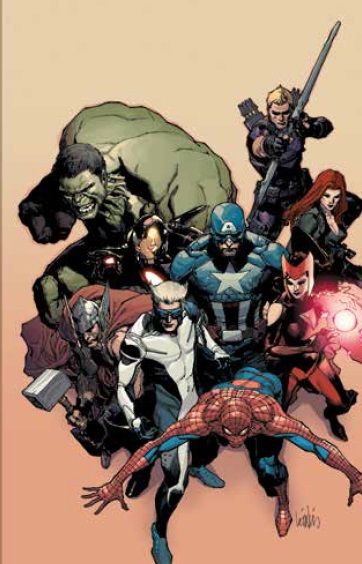What's a worse scenario than learning that Hydra has tampered with the time stream? In Mike Costa, Mast, Geoffo and Carmine Di Giandomenico's "Avengers Millennium" #1, the Avengers, Quicksilver and the Scarlet Witch discover the answer.
Costa's opening scene has solid prose and a strong attention-grabber. Through textboxes scattered in beats across two pages, he poses the question: what could be so dire that Quicksilver would run until he was "near collapse?" The answer -- that his sister, the Scarlet Witch, was very concerned about mysterious something buried in a Hydra compound -- is a letdown, partly because Costa stretches out the full reveal until the final page of the issue.
The hook is also weak because Hydra is a poor villain. The more memorable villains have outsized personalities or are appealing or sympathetic to the reader. While Hydra's facelessness and the unknown scale of its operations make it a realistic terrorist organization and a difficult foe to contain, these same qualities make it faceless. It's also been beaten too many times to inspire the dread that terrorism is supposed to conjure, even though it's as hard to kill as its namesake. With Hydra, the stakes are always epic, but only technically. On a visceral level, they don't usually leave an impression, and this is again the case in "Avengers: Millennium" #1: too much noise and not enough development that makes Hydra feel like a living, breathing threat.
As a miniseries debut and a quasi-tie-in to the upcoming Avengers movie this summer, "Avengers: Millennium" #1 is reader-friendly. It's no coincidence that Costa includes only the Avengers known from the movies plus Quicksilver and the Scarlet Witch, who will also have their big screen debuts.
Reader-friendliness is to little avail, though, because the plot is so very thin and decompressed. Mast and Geoffo, the storyboard artists, break down the action attractively with different camera angles and their visual pacing throughout has the intended cinematic effect of a vast visual tableaux. However, the balance is off. This is a four-issue miniseries, not a movie and also not a manga with twenty volumes and ample pages to fill. Content is sacrificed for visual fireworks and explosions or combat in almost every panel. The resulting story can be summed up in one sentence: superhero team gets a tip and their investigation moves them from Point A to Point B, where they locate the plot catalyst.
Captain America's deduction on the final page may induce a small moment of frisson, but Costa hasn't provided enough for readers to be invested. He's counting too heavily on readers' prior engagement from their previous exposure to the characters, and that's not a good move, especially since both plot and characterization are negligible. Spider-Man and Hawkeye's back-and-forth jabber about burgers is funny, but the banter is not just frivolous within the fictional situation; it's a throwaway on a narrative level, because it isn't attached to character development of more significance, nor is the humor specific to the story.
Di Giandomenico's facial expressions are a little stiff and rote-feeling. His fine line is uncluttered, and he uses perspective well to create lots of space and depth in the panels. Mossa's translucent, pale colors match well with Di Giandomenico's delicate black lines. However, Mossa colors many scenes in almost-monotones, which overemphasize the divisions between scenes and muddy the backgrounds. The action still glides from panel to panel due to the decompression, but there's a lack of oomph. Di Giandomenico's sequences feel like spacious and carefully arranged aerial mobiles. While pretty, they feel empty and don't convey the force and impact of bodies and weapons. The sense of motion is flawed, while the sense of space is good.
"Avengers: Millennium" #1 fails to create a good reason for readers to pick it up, despite how it features the same roster of characters as Marvel's next big summer movie.

